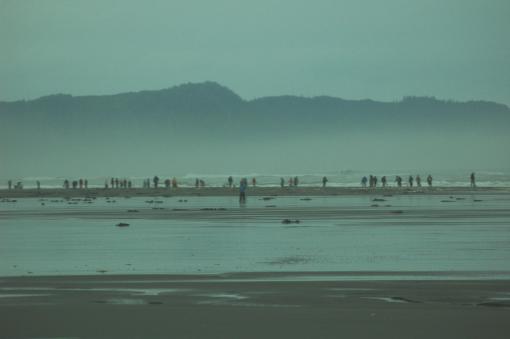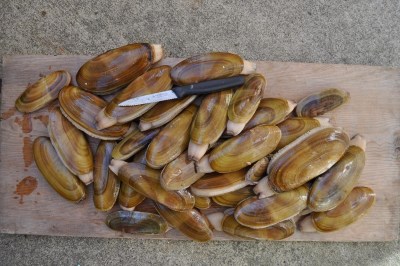If you’re a fan of razor clams, the coming of extreme low tides is cause for celebration, especially on the northern Oregon coast.
These large surf clams are considered a delicacy at fine restaurants serving Pacific Northwest cuisine, but they are yours for the taking … if you have a shellfish license, a clam shovel or clam gun, and some know-how.
(For other types of Oregon clamming, see: Best Clamming Bays in Oregon.)
Where to Dig
By far the largest population of razor clams in Oregon is located on the wide beaches from Seaside north to the Columbia River’s South Jetty, located west of Astoria. (Similar razor clam populations are located north of the Columbia in Washington.)
This part of northern Clatsop County is not only the best for razor clamming in the state, it’s also the nearest clamming for the largest number of Oregonians living in the greater Portland area.
Razor clams like the sand type and the fact that the beaches here have been very stable since the construction of the Columbia’s jetties during the late 1800s and early 1900s.
The remainder of Oregon’s coast has pockets of razor clam populations that some years can offer good clamming and sometimes very large clams.
However, these beaches can shift more and aren’t as consistent for razor clamming as northern Clatsop County.
When to Dig
Best Razor Clamming Tides
Several of the spring and early summer tides can be extremely low, which, coupled with often moderate conditions, allows clammers to get to razors usually covered by pounding surf.
Therefore, the lowest minus tide series starting in early spring are the most popular times to dig and the beaches from Seaside northward are covered with clammers.
How to Find and Dig
Razor clams leave a “show” in the sand. This telltale sign is a small hole or dimple in the sand about the size of a small button. Some shows even look light doughnuts with a raised area around the hole.
Very generally speaking, the larger the show, the larger the clam hiding beneath, but this is only a rule of thumb to help you increase your odds at locating bigger clams. Honestly, it’s not always accurate with every show.
A show can be revealed more clearly by pounding the handle of your clam shovel on the sand while you scan the beach in front of your feet as you walk along just above the water line.
Using a special clam shovel is a popular and efficient way to dig razor clams, once you get the hang of it.
Start your dig by pushing the shovel blade into the sand about 4 to 6 inches away from the show, on the ocean side of that dimple. Push the blade down vertically.
Working quickly, make a couple of digs, pushing the sand out from on top of the clam, and then try to grab the razor with your hands.
Quite a few razor clammers also use clam guns, which are easier to master, although the guns tend to break clam shells more often.
Other legal methods include catching them by hand (gotta be fast!) or using a tube as described in the ODFW Marine Zone regulations.
Spend a few moments watching some of the most productive razor clammers (there will be plenty around), and you’ll quickly improve your techniques.
Licenses and Regulations
The daily limit of razor clams in Oregon is the first 15 (regardless of size or condition) clams that you dig. You are not allowed to selectively release small or damaged clams, so learn to look for those bigger “shows” in an effort to grab the largest clams.
Diggers who are at least 12 years old must have a shellfish license. For youths ages 12-17, there is a combined angling, hunting and shellfish tag. Adult diggers need an annual shellfish tag.
All diggers must dig their own clams and keep them in their own container or bag. You may not possess more than one daily limit.
Clamming Season
Razor clamming is closed north of Tillamook Head from July 15 through September 30.
The remainder of Oregon beaches south of Tillamook Head are open year-round under annual razor clamming rules.
Razor Clamming Closures
Even with the above regular seasons, the Oregon Department of Fish and Wildlife and the Oregon Department of Agriculture occasionally enacts temporary clamming closures.
These short-term closures are most often enacted due to marine biotoxins, primarily naturally occurring domoic acid that can build up temporarily in clam meat and pose a health risk.
Razor clam toxin levels rise and fall, and the state’s agriculture department determines through testing samples just when levels are safe again for human consumption.
ODFW also has enacted temporary closures when clam sizes have been unusually small, in order to reduce harvests until the clams are a more desirable size for digging.
Razor clam closures often affect a select section of the coast.
Find the latest razor clamming closures and other information on the ODFW website, including on its weekly recreation report. These resources are linked at the bottom of this article.
Also, for more information about razor clamming in Oregon, check out this Oregon Department of Fish and Wildlife flyer.

Razor Clamming on Clatsop County Beaches
The 18 miles of beach stretching north from Tillamook Head (at the southern end of Seaside) north to the jetty west of Astoria are typically reliable — and often outstanding — for razor clamming.
In a good year, this long stretch of sand in Clatsop County can produce more than 2 million clams for recreational diggers.
Access is available at many points along this sandy stretch, although it takes a little more effort in the northern section, an area that includes Fort Stevens State Park.
The middle sections include Sunset and Del Ray beaches, both state recreation sites.
Razor Clamming Near Seaside
In and around the tourist towns of Gearhart and Seaside, with plenty of public beach access, offer plenty of easy to reach razor clamming at the southern end of Clatsop County.
These beaches are barely more than an hour’s drive from parts of the Portland area, making them easy to reach for a day trip. Seaside, Gearhart and other areas of Clatsop County also have plenty of hotels, beach houses and other rental properties if you’re looking to stay overnight.
Some years the Clatsop County clam populations vary by location, according to veteran ODFW shellfish biologist Matt Hunter.
For example, a particular year’s class of larger clams may be stronger in the south near Seaside and even to the north of the wreck of the Peter Iredale (Fort Stevens State Park) than it might be between those two ends. But other years it might be best in the middle, or some other variation.
Most clams harvested by recreational diggers are 1 to 3 years old, although Hunter said they can live up to 6 years in this region.
Razor clam larvae typically set down in the sand in late summer, which is why the most popular Oregon beach clamming locations (everything north of Tillamook Head) are closed to harvest for much of the summer (July 15-Sept. 30).
Driving on the beach is allowed in some areas on the coastline, including parts of Clatsop County. The areas where beach driving is allowed are marked with signs.
A four-wheel drive would be a good idea in some of those drivable beaches due to soft sand. Driving on the beach is not allowed in all areas, including in Seaside (where it’s easy to walk to the surf), so pay close attention.
More Oregon Razor Clamming Beaches
Newport Area Razor Clamming
Agate Beach and South Beach can be pretty good for razor clamming most years, although clam populations fluctuate.
This area may not be as consistent or productive as the far northern coast, but it’s more convenient for residents of Corvallis and Eugene.
Coos Bay Area Razor Clamming
North Spit and Bastendorff Beach (either side of Coos Bay entrance) and Whiskey Run Beach (north of Bandon) can all have reasonably good razor clamming.
If you live in Roseburg or Medford, this might be a place to find razor clams closer to home rather than driving to Seaside.
Lesser Known Razor Clamming Beaches in Oregon
Not all Oregon beaches are as popular for razor clamming as those around Seaside and Warrenton.
Beaches (and nearby cities) where you might also have success digging razor clams with less competition from other clammers include:
- Indian and Cannon Beaches (Cannon Beach)
- Short Sands Beach (Manzanita)
- Cape Meares Beach (Tillamook)
- Waldport Beach (Waldport)
- North Umpqua Spit (Reedsport)
- Meyers Creek Beach (Gold Beach).
Return to the Oregon Shellfish page
Oregon Resources
ODFW Weekly Fishing Report
ODFW Trout Stocking Schedule
Oregon Fishing Regulations
National Weather Service

